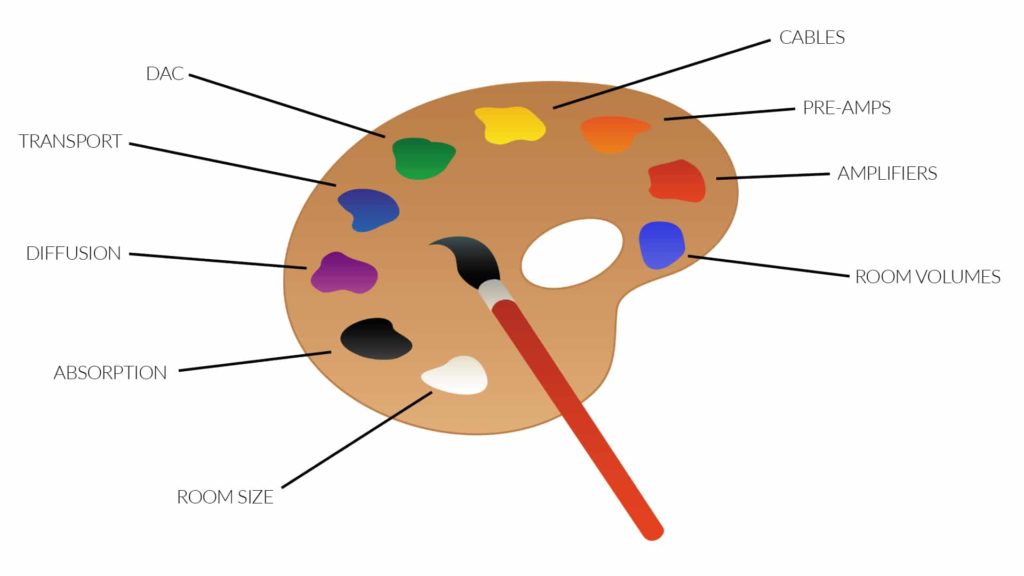Hi everyone, Dennis Foley from Acoustic Fields. Today we’re going to talk about the gear game. I get a lot of inquiries, we just crossed the 900 mark in our room analysis forums on our website. So we’ve had over 900 submissions about people’s room sized and volumes and helping them out with treatments and trying to minimize low frequency pressure issues.
So I see a lot of gear in these forums, I see a lot of listing of gear and quiet honestly the room really doesn’t care about the gear, it only cares about certain things, speakers, distances from side walls, diameter of low frequency drivers, how much energy you’re going to put in the room. So we’ll talk about that in another video but I want to talk about the gear game because there is a lot of promotion, there’s a lot of misunderstanding out there. So if we just step back a little bit, take a deep breath and look at the generic aspect of what we’re doing, I think we’ll get a better understanding.
What is your music system? It’s a combination of colorations. The amplifier has a color, the speakers have a color, the cables have a color, the room definitely has a color. So you have all these components that have different colors. So saying that this is the best or this is the best thing to do in this particular situation is not always the right answer. You have to have an understanding of the components themselves and what kind of colorations they add to the equation. So you have to have a good understanding of this.
And what you’re trying to do as you’re putting a system together is you’re trying to match the colorations of all the components. You’re trying to match the coloration of the speakers with the colorations of the amps. You’re trying to match the speed of the speakers with the speed of the amps. You try to match the tone of the pre-amp to the speed of the amps and the coloration of the amps so those two components have a good impact on the speakers. So if your speakers are slow in response, you probably don’t want to use tube amplifiers because they’re not necessarily that fast. You want to use maybe a solid state amplifier.
But the bottom line here is whatever you’re trying to do, you have to realize that every component has a color. Every component contributes something to the final sonic equation that you hear. And it takes time, it takes effort. And those of us that have been in the business a long time understand this. When you find the right combination of gear, you usually stray with it for a long time.
So we’re matching gear to gear obviously and the gear to the room is really critical. You know, you can’t have seven foot tall speakers in a seven foot tall room. There’s just certain rules that you have to go by. And more importantly gear to the room is the room to the listener. What is the usage? What are you trying to do in the room? Tube channel, home theater, control room, live room, vocal room, all different. All different acoustically, all different in terms of gear, all different in terms of the relationship from the gear to the room and definitely different in the room to the listener. So you have to take all of these things into consideration.
Back to our solid state versus tube. We know solid states are amplifiers – let’s just focus on amplifiers – are noted for speed, clarity, definition, tube’s a little bit more smoother, more analog, more colored. So maybe we pair a tube pre-amp with a solid state amplifier. And then we find the right speaker that works with the tube pre-amp and the solid state amplifier. There are certain speakers that work best with that combination. And then we have to make sure that the room is cooperating with our choices. So we want to make sure that we can have all of that in balance.
So maybe a tube front end and a solid state amplification system and a speaker that can handle that kind of speed in transparency from the solid state amplifiers. So you want to make sure that you take all of these things into consideration. There is no one right solution. If you give me a piece of gear and you tell me alright, what’s the best speaker to buy with that particular amplifier, I really can’t tell you. I can give you a choice, I can give you some ideas and some direction to go but the proof, the real proof is listening to it in your own room. So you want to be able to do that.
So we have the room to the listener, the gear to the gear and the gear to the room. It’s very very critical.
Low frequency energy and room volume. That’s a good thing for gear to the room. You must match the amount of energy you can put into a room to the size of the room and the volume of the room. That’s all critical.
So in the gear game we have to realize that we’re putting together a system. A system that has many colorations. So you want to match those colorations to each other, to the room and to the listener. So in this first graphic here you can see that matching components together is kind of like an artist’s pallet of colors. You take a little bit of color here and you paint it here on the canvas, a little bit of color from the amplifier, a little bit of color from the speaker, a little bit of color from the cables, the DAC, the pre-amp, all components have colors. The synergy or balance between those colors will bring you closer to your music.
Thank you,
Dennis
—
This is an unedited transcript from our video series from Acoustic Fields. There will be some errors in grammar and sentence structure that occur during this translation process.
For complete understanding and comprehension, please view the video which is included in this text. For any additional information regarding this topic or others relating to room acoustics, please contact us directly at:
P: 520 – 392 – 9486








